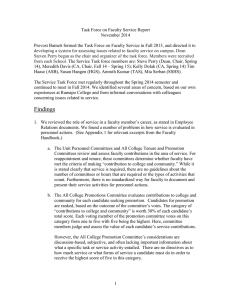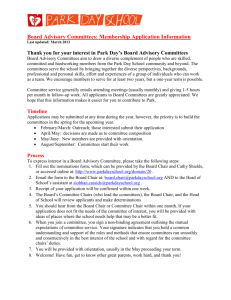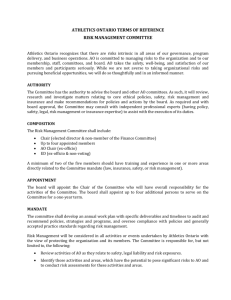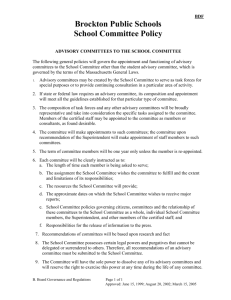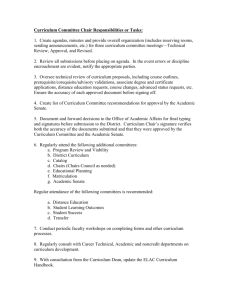Evaluation of Contribution to College and Community
advertisement
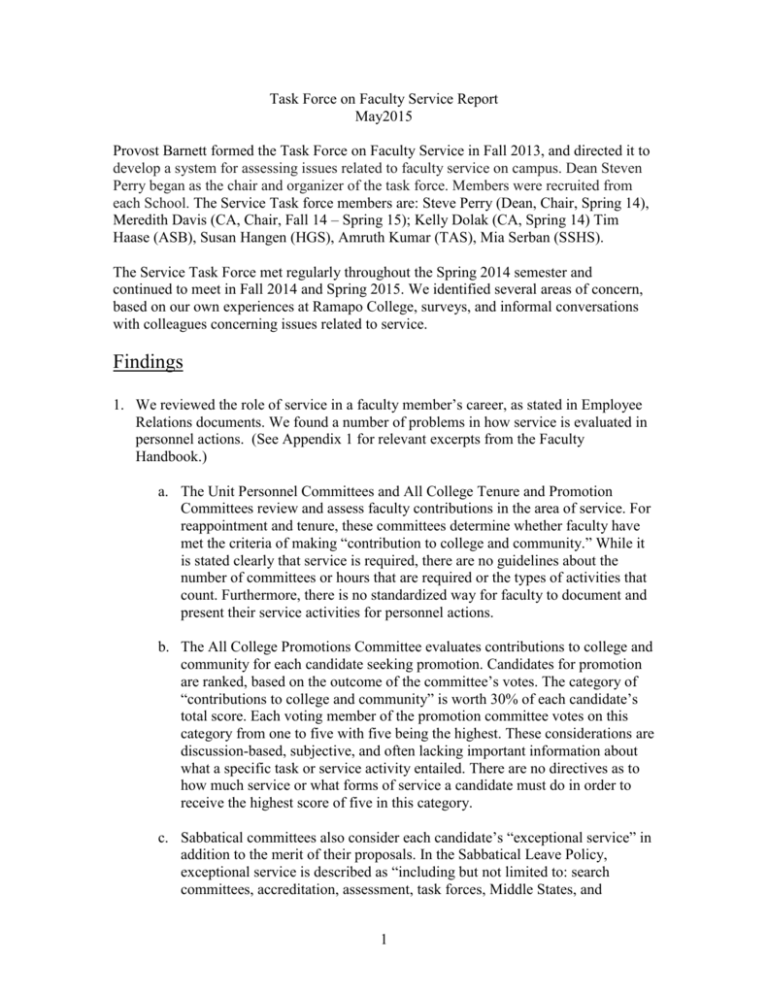
Task Force on Faculty Service Report May2015 Provost Barnett formed the Task Force on Faculty Service in Fall 2013, and directed it to develop a system for assessing issues related to faculty service on campus. Dean Steven Perry began as the chair and organizer of the task force. Members were recruited from each School. The Service Task force members are: Steve Perry (Dean, Chair, Spring 14), Meredith Davis (CA, Chair, Fall 14 – Spring 15); Kelly Dolak (CA, Spring 14) Tim Haase (ASB), Susan Hangen (HGS), Amruth Kumar (TAS), Mia Serban (SSHS). The Service Task Force met regularly throughout the Spring 2014 semester and continued to meet in Fall 2014 and Spring 2015. We identified several areas of concern, based on our own experiences at Ramapo College, surveys, and informal conversations with colleagues concerning issues related to service. Findings 1. We reviewed the role of service in a faculty member’s career, as stated in Employee Relations documents. We found a number of problems in how service is evaluated in personnel actions. (See Appendix 1 for relevant excerpts from the Faculty Handbook.) a. The Unit Personnel Committees and All College Tenure and Promotion Committees review and assess faculty contributions in the area of service. For reappointment and tenure, these committees determine whether faculty have met the criteria of making “contribution to college and community.” While it is stated clearly that service is required, there are no guidelines about the number of committees or hours that are required or the types of activities that count. Furthermore, there is no standardized way for faculty to document and present their service activities for personnel actions. b. The All College Promotions Committee evaluates contributions to college and community for each candidate seeking promotion. Candidates for promotion are ranked, based on the outcome of the committee’s votes. The category of “contributions to college and community” is worth 30% of each candidate’s total score. Each voting member of the promotion committee votes on this category from one to five with five being the highest. These considerations are discussion-based, subjective, and often lacking important information about what a specific task or service activity entailed. There are no directives as to how much service or what forms of service a candidate must do in order to receive the highest score of five in this category. c. Sabbatical committees also consider each candidate’s “exceptional service” in addition to the merit of their proposals. In the Sabbatical Leave Policy, exceptional service is described as “including but not limited to: search committees, accreditation, assessment, task forces, Middle States, and 1 demonstrated contributions to major college initiatives or college governance.” Yet the definition of “exceptional” remains unclear here. There are no guidelines as to what amount of service or what specific forms of service are necessary to meet the minimum expectation of service and thus no objective way of determining what counts as “exceptional.” d. Similarly, Career Development funding decisions also take service into account, without clear expectations expressed. 2. We identified problems with how service is managed at the college by drawing on the experiences and knowledge of committee members and faculty feedback. The problems we identified are: a. the lack of clarity about the actual expectations for service in terms of numbers of committees, activities, or hours spent. b. the lack of a clear definition of what constitutes “service. ” For example, is attending faculty assembly meeting service? Or does only serving on FAEC count as service? Is assessment service? c. the lack of a method to measure service fairly and equitably across units and to compare the value of various activities. d. the widespread feeling that the service workload is heavy and at times burdensome. e. the perception that faculty are unequally engaged in conducting service, and that relatively few faculty carry out the bulk of the service activities. f. the concern that junior faculty are unfairly evaluated because service expectations are unclear and subjective. g. the sense that faculty may be under-motivated to perform service or unclear about their responsibilities, because service expectations are not clearly defined. h. the sense that service activities with high visibility to other faculty members are more beneficial in terms of promotion, tenure, etc. than other activities, which may contribute as much to the college’s mission and/or strategic goals. 3. Third, our group collected information about what activities the faculty consider to be service, and what service activities faculty are conducting. We compiled a list of all of these activities, based on our own knowledge and experience. Then, each committee member asked colleagues in his/her unit to review this list and identify additional service activities that were omitted. We developed the following list of service activities (see Appendix 2). This list demonstrates that a huge range and large number of activities fall under the category of service. Recommendations: 1. Adopt the following definition of service: Service comprises activities in support of the mission and strategic goals of the College including but not limited to governance, student engagement, academics, campus life and institutional support, non –compensated or otherwise. 2 i. Attendance at meetings such as FA, Unit and convening group are included in service. This should be clarified in upcoming revisions to criteria. a. Service should be more clearly distinguished from Professional Responsibility, which is a code of conduct, while service constitutes than a specific portion (30%) of a faculty member’s contributions to the college in personnel actions. b. Service that is compensated should be differentiated from noncompensated service.; For example, a program coordinator or convener who receives course release and/or a stipend should distinguish this work from their uncompensated not count this work as “service. c. When contributions to the college are compensated with release time, faculty should indicate this fact on any documents, such as CVs and yearend reports, and list these separately from their non-compensated work. a. ” A convener who is compensated with release time and who also uses their flex time to cover their duties cannot count this work as “ser When contributions to the college are compensated with release time, faculty should indicate this fact on any documents, such as CVs and year-end reports, and list these separately from their non-compensated work. 2. Maintain an updated list of service opportunities at the college on an ongoing basis and make it publicly available. The Service Task Force has compiled a list as of November 2014. However, the list will always be somewhat in flux, as new forms of service emerge in response to changing needs at the college. 3. We recommend that faculty begin to document their service contributions voluntarily and confidentially in terms of time spent on these tasks, and that they share this data in their personnel documents. We recommend that committees take labor hours into account to objectively evaluate service. Adding information on time spent would help to make evaluation more accurate because the requirements of particular service activities are not constant. Even identical committees can vary from semester to semester, and for different individuals. For example, a search committee with 250 applications is more work than one with 45 applications, and yet they appear the same when listed on a C.V. Chairing a committee may require double the time spent by a committee member, or require the same amount of time. Another example: ARC meets for approximately 40 hours per semester, and requires approximately 8-10 hours of outside work per semester, while another all-college committee might meet for 8 hours in a year. 4. Develop a log sheet that can be used by faculty to track their service hours. Alternatively, faculty might use any number of apps or other tools to keep track of the work they do. 5. Create a qualtrics questionnaire to survey faculty each semester about the hours spend on service labor. This information could be shared with faculty, who would have a 3 clearer idea of what constituted “average”, “below average” or “exceptional” service. This would make service expectations more clear and concrete. a. The data generated through these surveys could eventually be used to establish clear guidelines. For example, we might recommend that a tenure track assistant professor should commit a range of hours per semester on service contributions, after their first year. b. The surveys would also demonstrate to the college the number of hours that faculty provide as labor in terms of service and thus would enable the college to calculate the value that faculty contribute to the administrative side of the college, and the expenses related to service. 6. In order to ensure a more equitable distribution of service and to ensure that junior faculty have a fair chance to meet criteria for tenure regarding service, the college should implement a more formalized mentorship program. A structure such as a single mentor per unit or a few for the college would be possible. The Faculty Resource Center should also hold workshops on Faculty Service, presenting and explaining various opportunities on campus and providing guidance on how to fulfill expectations for service. 7. Continue to consider qualitative assessment: as demonstrated in Appendix 2, there are many kinds of work that fall under the category of service. Some are essential to student engagement or shared governance, others directly impact students or campus life. Faculty should clearly relate service contributions to the college’s mission and strategic goals in their documentation. 8. Qualitative Measures: faculty should be encouraged to explicitly relate service contributions to the college’s mission and strategic goals in their documentation. 9. New Committees and Service Tasks: When charging a new committee, task force, or service position, Faculty Assembly, the Provost, Dean or Convener should make clear the estimated time that this work will require, so that the “expense” in terms of faculty time can be more accurately documented. Timeline for Implementing Service Task Force Recommendations: May -August 2015: Develop some helpful hints for faculty to aid in logging hours spent on service (including recommending some apps and a sample log sheet) September 2015: Faculty begin to independently track their hours January 2016: Survey of semester 1 sent out to all faculty May 2016: Survey of semester 2 sent out to all faculty June 2016: Analyze data generated by faculty surveys in AY 2015-16. Fall 2016: Present preliminary findings to FA and Provost, suggest alterations to the survey or other changes. Continue to survey faculty. May 2017: Analyze data from AY 2016-17 and compare to AY15-16. Fall 2017: Suggest broad guidelines for “hours spent” for various ranks, (asst. Professor, Associate, Full). 4 . Appendices: 1. Personnel Policies Referring to Service in Faculty Handbook 2. List of Service Activities at RCNJ as of Spring 2014 3. Sample Log Sheet 5 Appendix 1: Personnel Policies Referring to Service in Faculty Handbook 5.3 CONTRIBUTION TO COLLEGE AND COMMUNITY "Contribution to College" is a form of Service to the College and is required for reappointment, promotion, and reappointment with tenure. Contribution to College includes participation in committee work on the school, division, or all-college level or working involvement in the governance structure. It can also entail serving in an advisory capacity to College organizations, engaging in special projects, contributing to the development of campus resources or to one's discipline by participation in appropriate organizations including effective contribution to professional organizations. In addition, the obtaining of grants for College developed programs is a contribution to the College. Further, candidates for accelerated tenure shall show evidence of extraordinary service to Ramapo College and the community, broadly defined to include programmatic, unit, or College needs, advising, mentoring, and public or community service, and may supplement this evidence with documented prior academic or community service activities, with greater weight given to service performed at Ramapo College. "Contribution to community" is not required but is considered for reappointment, promotion, or reappointment with tenure in addition to contributions to College. Contribution to community refers to developing College programs, which respond to genuine community need, or promoting substantial community participation in College programs. It also entails participation by faculty members in community service and governmental organizations or service in consulting capacities in such organizations when this is relevant to their work at the College. 9.2 ALL COLLEGE PROMOTION COMMITTEE PROCEDURES V. Criteria for Promotion to Associate Professor Evaluation of Contribution to College and Community 1. Contributions to College include participation in Committee work on the school, division, or campus level or working involvement in the governance structure. It can also entail serving in an advisory capacity to College organizations, engaging in special projects, contributing to the development of campus resources or to one's discipline by participation in appropriate organizations. In addition, the obtaining of grants for College programs is a contribution to the College. 2. Contribution to community refers to developing College programs that respond to genuine community need or promoting substantial community participation in College programs. It also entails participation by faculty members in community service and governmental organizations or service in consulting 6 capacities in such organizations when this is relevant to the applicant's work at the College, including effective contribution to professional organizations. 3. Applicants who once held administrative positions and who wish to submit contributions to the College and Community made during their term of administrative office must provide descriptions of their contractual responsibilities. Only those contributions to College and Community that were not a part of their job responsibilities can be considered for promotion (such as volunteering for a variety of College and Community committees, workshops, forums, and other group activities apart from the assigned administrative committee responsibilities). [See 2/4/93 letter from S. Raciti to the 1992/1993 All-College Promotion Committee]. VI. CRITERIA FOR PROMOTION TO FULL PROFESSOR E. Evaluation of Contribution to College and Community 1. Contributions to College include participation in committee work on the school, division, or campus level or working involvement in the governance structure. It can also entail serving in an advisory capacity to College organizations, engaging in special projects, contributing to the development of campus resources or to one's discipline by participation in appropriate organizations. In addition, the obtaining of grants for College programs is a contribution to the College. 2. Contribution to community refers to developing College programs that respond to genuine community need or promoting substantial community participation in College programs. It also entails participation by faculty members in community service and governmental organizations or service in consulting capacities in such organizations when this is relevant to the applicant's work at the College, including effective contribution to professional organizations. 3. Applicants who once held administrative positions and who wish to submit contributions to the College and Community made during their term of administrative office must provide descriptions of their contractual responsibilities. Only those contributions to College and Community that were not a part of their job responsibilities can be considered for promotion (such as volunteering for a variety of College and Community Committees, workshops, forums, and other group activities apart from the assigned administrative committee responsibilities). [See 2/4/93 letter from S. Raciti to the 1992/1993 All-College Promotion Committee]. VII. PROCEDURES FOR EVALUATION OF CANDIDATES 7. Voting shall be by secret ballot. Votes should be taken separately on the three categories of teaching, scholarly achievement, and contribution to College and community. Each voting member of the Committee shall vote one to five, with five being the highest. Those applicants who fail to meet the minimum standards (averaging below 2) in any of the three categories will not 7 be recommended for Promotion. Applicants who meet the minimum standards (averaging 2 or higher) in all three categories will be recommended for Promotion. F. Committee's Ranking Procedure Candidates recommended for promotion shall be ranked Recommended or Strongly Recommended. This ranking will be based upon the vote taken separately on the three categories of teaching, scholarly achievement, and contribution to College and community. Effective teaching will be evaluated at 40% of the total vote, scholarship/professional achievement and contribution to college and community will each be evaluated at 30%. No ranking shall occur until all appeals have been processed. 11.0 Sabbatical Leave Policy 5c. Exceptional Service In addition to Merit and Past Performance, the committee will consider the applicant’s exceptional service to the college, including but not limited to: search committees, accreditation, assessment, task forces, Middle States, and demonstrated contributions to major college initiatives or college governance. Exceptional service may be demonstrated by: letter(s) from Ramapo College colleague(s) or an external colleague(s) describing the service performed by the candidate and the positive benefits of the service to the College or Ramapo College students; a description of the candidate’s participation and the positive benefits of the service to the College or Ramapo College students; or other materials that demonstrate exceptional service. 8 Appendix 2: list of Service Opportunities, complied by Task Force members through outreach to faculty members in all Units. PERSONNEL Tenure Chair/Member Promotion Chair/Member Sabbatical Chair/Member Faculty Development Funding Chair/Member Career Development Chair/Member Search Committee Chair/Member Staff Recognition Committee Awards committees (Bischoff, Campana, etc.) Mentoring of junior faculty GOVERNANCE Faculty Assembly President Faculty Assembly Secretary Faculty Assembly Executive Council FAEC liaison to Board of Trustees committees ARC—Academic Review Committee Chair/Member AFT President Task Force on an academic topic Chair/Member DAC—Diversity Action Committee Chair/Member TLTR—Teaching and Learning Technology Roundtable Faculty Representative on Board of Trustees committees American Democracy Project The Salameno Center for British Studies Advisory Board IRAC (International Risk Assessment Committee Convener Concentration Coordinator Emergency Preparedness Team Institutional Effectiveness Committee Instructional Design Center (chair, member, workshop coordinator) Faculty Resource Center (workshop coordinator, presenter, advisory board) Service to the Women’s Center Web Council Conference Committee Strategic Plan Task Force Health and Safety Committee Campus advisor based on disciplinary expertise (landscaping, logo design) Greater Expectations Research, Planning and Review Committee Budget Committee 9 Policy Review Committee Sustainable Living Facilities Committee International Education Committee Governance Review Committee Strategic Enrollment Management Retention Committee Service to Professional Bodies Faculty Resource Center Director STUDENT ENGAGEMENT President’s Alcohol and Other Drug Task Force Emergency Planning Committee International Risk Assessment Committee Student Engagement Boards for first and second year student engagement Athletic Advisory Committee CEC Design Team Advisor to student clubs and organizations Alternative Spring Break trip leader BIT—Behavioral Intervention Team Judicial Board Mentoring students for academic conferences and competitions Directing/ Supporting student performances End of year student showcases of student work College Health and Safety Council Student Club Advisor Student Affairs Volunteer for Family Day ACADEMIC Faculty/ Student Research Study Abroad Committee WAC—Writing across the Curriculum Chair/Member Connect Faculty Advisory Board Student Research Symposium Committee Unit Assessment Coordinator Honors Program Advisory Council Honor Society Advisor OSS Advisory Board Advisement Advisory Board Middle States Committees GECCo FYS Summer Book Selection Committee FYE Committee Supervising Adjunct Faculty Co-op/Internship/ Independent Study Advisor 10 Independent Study Instructor Director of graduate program Graduate Council International Education Committee EOF Advisory Board Poster Day Committee Recruitment Retention Advisement Promotion of major Equipment research and purchasing decisions Maintaining facilities Curriculum Committee (Is this a duplicate?) Service Learning Chair Living Learning Community Coordinator SSHGS Recruitment Committee Portfolio Review Committee STEM Committee for Teacher Education SPECIAL PROGRAMS Visual Arts Lecture and Workshop Series Cinematheque Series Planning Writers’ Series Fieldwork and site visits (outside class meeting time?) Deans’ Lecture Series Readings At Ramapo Series Platinum Series Planning Colloquium Committee Schomburg Committee INSTITUTIONAL Commencement planning Providing performance or service for college events American Democracy Project Liaison to Alumni Advisory Board Faculty Pedagogy Development Committee School Website Webmasters Presentations at Faculty Conferences Grant-Related Service IRB (Institutional Review Board for Human Research) Chair/ Member All-College Veterans Committee Newsletter Committee Office of Fellowships and Scholarships 11 Appendix 3: Sample of a “Log Sheet” that could be used by Faculty to track service hours. Faculty Service Log Faculty Name: ____________________________________________________ Faculty Status: ____________________________________________________ Name of service activity Dates of service Function2 Type of service activity1 Overall hours spent3 Comments4 Convening Group, Unit, All College, etc. Chair, Member, Representative, etc. 3 This includes but is not limited to: meetings, preparation outside of meetings, acting within the capacity of committee duties, etc. 4 Please attach a separate sheet with comments if necessary 1 2 12
